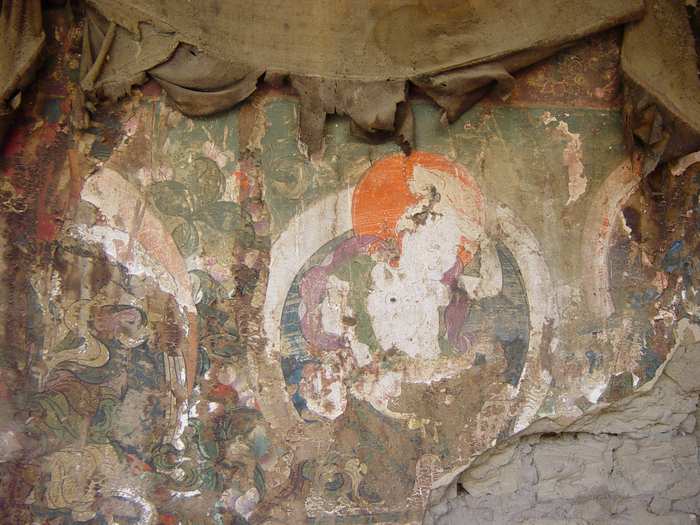
High Peaks Pure Earth has translated a blogpost by Woeser, originally written for the Mandarin service of Radio Free Asia and published on her blog on September 30, 2016.
Woeser writes about two places in Lhasa which now lie in ruins, Shideling and Yabzhi Taktser, both buildings she has written about extensively before.
For those who follow Woeser on Facebook, Twitter and Instagram, the photo post of ruins after her nightly prostrations have become a familiar sight. Below, she gives insight into the reasons behind her posting photos of ruins on social media.
My ‘Ruins Photography’
By Woeser
I have always had a special interest in the many ruins that are scattered across the vast Tibetan territory and specifically those found around the city of Lhasa. These ruins are almost without exception a product of the political violence of the contemporary era. How does my interest in ruins manifest itself? Well, I write about them and I take photos. If I could draw or write music, my drawings, music and voice would also become testimonies of ruins. Yes testimonies, or perhaps I should say evidence. My written and visual records over the years have mainly focused on the following two ruins: Shideling and Yabzhi Taktser; the former was once a monastery or more precisely a monastic school, the latter used to be the Lhasa residence of the Dalai Lama’s parents and family members.

My writings regarding ruins are scattered over more than 10 books I’ve written in Chinese. Apart from writings, I have always liked to use my “ruins photography” to reveal Lhasa’s history and Lhasa’s geography which has been occupied, suppressed and made invisible. Just like a city within a city, a people within a people, as well as death among death, there are a great deal of details within the ruins; I particular focus on little things like the blossoming flowers in the vast courtyard, the dead spider hanging in mid-air in the area where the main building subsides, the remains of newspaper cuttings of the “Tibet Daily” or posters of Chinese celebrities on various walls, the old and broken mirror attached to a pillar in the main hall or the flooring in some room that was once made from aga soil and that must have been more solid than today’s ceramic tiles; in fact, weeds and plants are growing through the clay surface. From these details I have come to understand many things that would otherwise be difficult to express.
I am by no means a professional photographer. So in my ruins photography I simply followed my heart and used various kinds of equipment, including film cameras, digital cameras (normal and digital SLR), GoPro and even my mobile phone. In fact, using GoPro and mobile phones to take photos is extremely addictive, you can take thousands of photos in one go. The large quantity of images that I produced are like photographic chronicles of those two ruins, they possess, so I believe, documentary value and are important records of distinct areas in the city of Lhasa that are on the verge of disappearing. Occasionally I would also take selfies, once with the broken murals of Shideling in the background, once in front of the broken mirror in Yabzhi Taktser; the person in the mirror, however, does and at the same time does not resemble me; it resembles some person who used to live here many years ago. This feeling of alienation paired with a feeling of attachment and intimacy will be etched on my memory forever.
If you happen to pay attention, you would have noticed that every night, I post about doing 108 prostrations on several social media outlets (actually, I have long exceeded this number) and prayers in appreciation of His Holiness to which I have been attaching photos of the two ruins for the past year; this shows that I find many profound meanings within these ruins. Every single part, every single shadow possesses a secret code to Lhasa and to Tibet. Just like the book “Photography” that conserves old Paris through photographs, on which a photographer once commented: “He regards Paris as a museum–photography protects its history and becomes a special, magical protective talisman and an integral part of the city;” “He wants to leave behind a testimony of the past, through the power of photography he wants to preserve the lost scenes, atmosphere and unity of the city.” This is precisely what I also hope to achieve.

The difference between the two ruins is that Shideling used to be half open to the public (today, it has also been sealed off) and its surroundings are occupied by several dozens of families, so one encounters all kinds of daily life activities in the area: one sees housewives boiling water or soup over solar stoves, one sees carpenters being busy with with sawing and plaining, one sees young girls moving flowers and plants into the sun or taking freshly washed and air-dried quilts back into the house, one sees five or six young guys and girls sitting in circles and playing Mahjong. Once I met an elderly nun, sitting on the stairs, turning her prayer wheel and started talking to her. I learnt that she used to live away from civilisation in a cave to practice Buddhism, but was driven away by military police and isn’t sure whether she can ever return. One often comes across Chinese and Hui who rent apartments; once I encountered an old Chinese man in his sixties, his mouth full of stained teeth, who had nothing but complaints about this place; he hated it here, but also didn’t want to go back home, I wonder where he will spend the rest of his life? Yabzhi Taktser, in contrast, has long been closed for the public, the only people that I ever saw entering were Chinese migrants who used it to lock their bicycles and motor bikes and Chinese proprietors who used the outer circle to raise Tibetan mastiffs; these seemed to be the only people who had permission to enter the building complex.
Let me add that I also encountered many animals at both ruins. The cats and dogs of Shideling and Yabzhi Taktser all possess special characteristics and personalities. For example, there was one black dog who was deceitful, but also particularly cowardly. When I provoked it, chased it with my selfie stick to take photos, it was both angry and scared, seeking shelter underneath the solar stove in the ruins; as soon as it realised that I was no longer chasing it (or did no longer want to chase it), it revealed its fierceness, barking viciously; it was hilarious. At Yabzhi Taktser, four or five pitch-black and fierce-looking Tibetan mastiffs were locked on the second floor of the outer courtyard, only revealing their sharp teeth and desperate eyes; they belonged to some Chinese businessman who was running a restaurant nearby and was keeping them as commodities to be sold. What was funny was that when this guy who only spoke Sichuan dialect called a Tibetan security guard to kick us out and in Tibetan I asked “tell me, who is the actual owner of this place?” The Tibetan guard looked bewildered.
Apart from this, the only trace of life that I found within these ruins was already dead, a dead spider suspended in the web that it had woven itself, hanging there in mid-air. It seemed to be the only master, protecting the ruins and protecting the past. I took a close-up shot of it hanging there; its dead body and the dilapidated environment presented a bizarre scene, as if there was a greater and deeper meaning behind it. Back then, however, there must have been more animals than just spiders living here. They definitely had cats, rats and dogs, namely the Apso, a special Lhasa dog. The animals of hosts were allowed to enter the main hall, the living room, even the bedrooms. The big dogs, like Tibetan mastiffs, would guard the entrance together with human guards, either in the courtyard or at the main gate. Of course, spiders are a lot more resilient than cats or dogs; they can easily hide and thus easily survive; eventually, they die lonely, suspended in an almost invisible web, just like it is in our very own unpredictable life.

The most unforgettable artefacts within the ruins are the murals of Shideling. The first time I saw them was in 2003, from the left to the right, from the back to the front, I saw remains of damaged and broken murals. If I had not seen this with my own eyes, I would never have believed that this place harbours treasures of such astonishing beauty. Nature and human interference have caused the murals to peel off and crack; but their three-dimensional texture has not been entirely lost and their pure and colourful character has not fully faded away. This is because of the special mineral pigments that were used. When we look at the details, we see many Bodhisattvas smiling, see their subtle fingerprints and the angry round eyes of the devils… in the left-hand corner of the first floor, there is a small patch of murals that really captured me, it was as if it harboured my very own inner secrets; subsequently, every time I went there, I felt anxious and nervous, I was afraid these murals would disappear. So once, I entered into the ruins and stood right in front of the murals to take several digital photographs of them; it felt as if I became one with the murals and I was no longer afraid that they would be lost. Behind the scripture hall, in the age-old prayer hall there is one wall full of portraits of sitting Buddhas, neatly arranged in a peaceful setting; I noticed that on one portrait there was a tiny hole in between the eyebrows of a Buddha, it looked like the trace of a bullet. When I returned another time, however, parts of this wall had already collapsed and unfortunately, the part with the hole had also disappeared.

Another scene that I will never forget is Shideling covered in snow. It looked very different. The dilapidated and broken ruins were by no means covered up by the snow. On the contrary, they looked even more desolate and disintegrated. A couple of kids came running over who wanted me to take their photo. Their faces were covered in frost, their noses were running, their expressions stiff; the black mastiff tied up next to us was wearing a red woollen scarf, it was subtly trembling in the freezing cold. This reminds us of Orhan Pamuk who wrote about the former existence of the city of Istanbul: “On snowy days, Istanbul felt like an outpost, but the contemplation of our common fate drew us closer to our fabulous past.”
Some news about Shideling’s situation today were revealed on the ninth day of 2016. On that day the Lhasa-based “Tibet Business Daily” claimed: “Shideling will be restored and opened to the public as a museum”. In the article, it said: “The planner Mr. Chen explained that the restoration work focuses on the central building of Shideling which is the main prayer hall, but this hall is also the most severely damaged part of the monastery and thus the most difficult task for the planners … the planners started off by consulting many photographs from the 1950s and also carried out several on-site surveys of Shideling’s remains … the restored Shideling will be turned into a museum and opened to the public.”

This reminded me of the fifth Reting Rinpoche who back then presented a report to the local authorities requesting to restore Shideling but was refused. It also reminded me of a Beijing photographer with a Hong Kong ID who once advised the authorities to turn the ruins of Shideling into an exhibition hall with “patriotism” as its main theme. At the same time, the Hong Kong-based magazine “Asia Week” published an article titled “The Patriotic Sentiment that Han Chinese and Tibetans Must Not Forget” in their 35th issue written by senior journalist Ji Shuoming. He used the style of a Party newspaper to rewrite the history of the fifth Reting Rinpoche, particularly claiming that he “was secretly poisoned by separatists back then because he maintained a normal relationship with the Central Government…” Even more detached from the facts is the following part, a plot of a red TV series broadcast by CCTV: “A loyalist questioned Reting Rinpoche: ‘when did Tibet feel close to China?’ Reting answered with devotion and righteousness: ‘In 1904, the British army under Francis Younghusband forcefully entered Lhasa, the military reparations were assumed by the Chinese Central Government, hence if it had not been for China’s money, how would Tibet have been saved?’” With regards to the question of how Shideling was destroyed, it was stated: “After the death of Reting Rinpoche, Taktra Rinpoche sent someone to move his body to Shideling Monastery, which was later on taken over by some thugs who burned it down. Hence, Shideling Monastery is now in ruins”.
This article also provided several quotes of a seemingly omnipotent “Tibet related photographer”, claiming that this warm-hearted and mysterious person wants to produce a documentary and TV series about “the story of how Reting Rinpoche died for his country”, planning to restore the ruins of Shideling, displaying so-called cultural documents of “ethnic unity” in its interior. In fact, this is an attempt to turn the ruins of Shideling into a “red scenic spot”, telling all tourists this kind of story: after the great patriot, the fifth Reting Rinpoche, was poisoned by British imperialists and Tibetan separatists, his monastery was destroyed by Tibetan separatists; today, under the efforts of Han-Tibetan unity and all people living in our united ancestral land, it has been restored to its original state.
There are simply too many reckless facts to be followed up. I used an entire day to once again look at the several thousand photographs that I took of the ruins of Shideling. Just like Gendun Chonphel, the fifth Reting Rinpoche was moulded into and celebrated as a “great patriot”. There is really nothing more fake and deceitful than this. But I know that my photography of Shideling’s ruins is an important record of the gradually disappearing spaces in old Lhasa; I know that I will keep writing about these ruins that are on the verge of being transformed, will keep writing about Yabzhi Taktser whose future remains unknown; I was deeply inspired by a Tibetan poet named Gade Tsering who wrote the following verses: “The ruins are covered in white frost, a divine ray of light / descends from the sky.” Yes, did you see it? In the divine light of karma and reincarnation, the ruins of Tibet that have been destroyed over and over again, have already become eternal.
2016





Thank you for telling this story of Shideling. Unbearably sad, but sheds light where from here all has been in shadow.